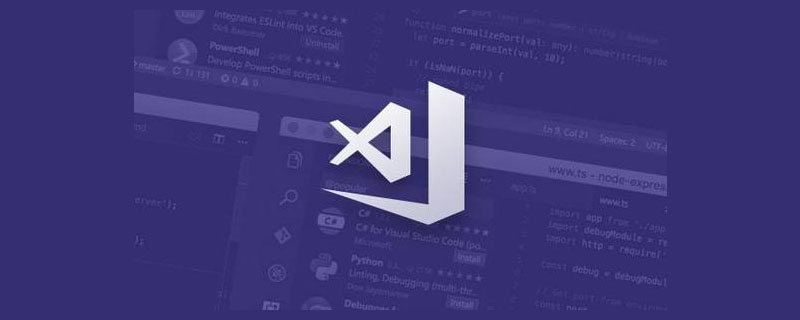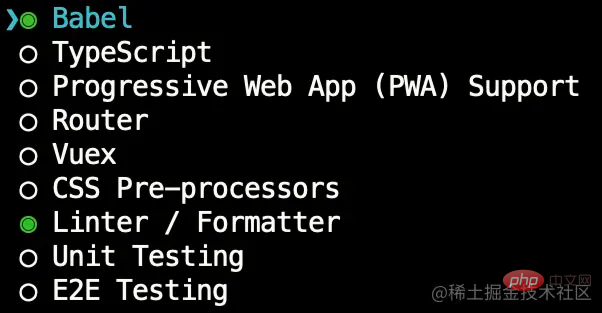A brief analysis of how to use eslint and prettier in vscode
How to use eslint and prettier in vscode? The following article will introduce to you the usage of eslint in vscode and the combined use of eslint and prettier. I hope it will be helpful to you!

1. Use of eslint in vscode
1) First install eslint in vscode, and then add the following code to settings.json of vscode
1 2 3 4 5 |
|
2) eslint must be installed in the project (or installed globally)
This is the requirement for the eslint plug-in in vscode: [Recommended study: "vscode Getting Started Tutorial"]

3) Add the .eslintrc.js file in the root directory and add the following code
1 2 3 4 5 6 7 8 9 10 11 |
|
4) Settings in rules
1 2 3 4 5 6 |
|
- Setting the first element in the attribute value array

- Setting the second element in the attribute value array
eslint.bootcss.com/docs/rules/ Find the corresponding attribute, click to enter, and then find options
- eslint:recommended The default rules are marked

Note: At this time, the project will be prompted according to the default settings and the rules in rules, and it will also be formatted according to the eslint rules when saving.
2. Use eslint in combination with prettier
(Note: The combination of eslint and prettier depends on the situation, and it does not have to be used together with prettier)
1) First of all, Install the prettier plug-in in vscode, and then add the following code in settings.json in vscode
1 2 3 4 5 6 7 |
|
2) Install prettier

in the project and also You need to install eslint-plugin-prettier and eslint-config-prettier. The purpose of these two plug-ins is to enable eslint to prompt according to the rules of prettier (note that these two plug-ins Version number problem, there is a problem when using the latest eslint-plugin-prettier version 4.0)
1 2 |
|
Then add plugin:prettier/recommended## to the extends in .eslintrc.js #
1 |
|

.prettierrc.js file in the root directory, eslint will follow The rules inside will prompt, and when saving, it will be formatted according to the rules inside
1 2 3 4 5 |
|

1 2 3 4 5 |
|
1 2 3 4 |
|
Note: After modifying some configurations, vscode may not take effect immediately. Close the project and reopen it to try
For more knowledge about VSCode, please visit:vscode tutorial! !
The above is the detailed content of A brief analysis of how to use eslint and prettier in vscode. For more information, please follow other related articles on the PHP Chinese website!

Hot AI Tools

Undresser.AI Undress
AI-powered app for creating realistic nude photos

AI Clothes Remover
Online AI tool for removing clothes from photos.

Undress AI Tool
Undress images for free

Clothoff.io
AI clothes remover

Video Face Swap
Swap faces in any video effortlessly with our completely free AI face swap tool!

Hot Article

Hot Tools

Notepad++7.3.1
Easy-to-use and free code editor

SublimeText3 Chinese version
Chinese version, very easy to use

Zend Studio 13.0.1
Powerful PHP integrated development environment

Dreamweaver CS6
Visual web development tools

SublimeText3 Mac version
God-level code editing software (SublimeText3)

Hot Topics
 1652
1652
 14
14
 1413
1413
 52
52
 1304
1304
 25
25
 1251
1251
 29
29
 1224
1224
 24
24
 How to define header files for vscode
Apr 15, 2025 pm 09:09 PM
How to define header files for vscode
Apr 15, 2025 pm 09:09 PM
How to define header files using Visual Studio Code? Create a header file and declare symbols in the header file using the .h or .hpp suffix name (such as classes, functions, variables) Compile the program using the #include directive to include the header file in the source file. The header file will be included and the declared symbols are available.
 What computer configuration is required for vscode
Apr 15, 2025 pm 09:48 PM
What computer configuration is required for vscode
Apr 15, 2025 pm 09:48 PM
VS Code system requirements: Operating system: Windows 10 and above, macOS 10.12 and above, Linux distribution processor: minimum 1.6 GHz, recommended 2.0 GHz and above memory: minimum 512 MB, recommended 4 GB and above storage space: minimum 250 MB, recommended 1 GB and above other requirements: stable network connection, Xorg/Wayland (Linux)
 vscode terminal usage tutorial
Apr 15, 2025 pm 10:09 PM
vscode terminal usage tutorial
Apr 15, 2025 pm 10:09 PM
vscode built-in terminal is a development tool that allows running commands and scripts within the editor to simplify the development process. How to use vscode terminal: Open the terminal with the shortcut key (Ctrl/Cmd). Enter a command or run the script. Use hotkeys (such as Ctrl L to clear the terminal). Change the working directory (such as the cd command). Advanced features include debug mode, automatic code snippet completion, and interactive command history.
 Where to write code in vscode
Apr 15, 2025 pm 09:54 PM
Where to write code in vscode
Apr 15, 2025 pm 09:54 PM
Writing code in Visual Studio Code (VSCode) is simple and easy to use. Just install VSCode, create a project, select a language, create a file, write code, save and run it. The advantages of VSCode include cross-platform, free and open source, powerful features, rich extensions, and lightweight and fast.
 How to solve the problem of vscode Chinese annotations becoming question marks
Apr 15, 2025 pm 11:36 PM
How to solve the problem of vscode Chinese annotations becoming question marks
Apr 15, 2025 pm 11:36 PM
How to solve the problem that Chinese comments in Visual Studio Code become question marks: Check the file encoding and make sure it is "UTF-8 without BOM". Change the font to a font that supports Chinese characters, such as "Song Style" or "Microsoft Yahei". Reinstall the font. Enable Unicode support. Upgrade VSCode, restart the computer, and recreate the source file.
 Common commands for vscode terminal
Apr 15, 2025 pm 10:06 PM
Common commands for vscode terminal
Apr 15, 2025 pm 10:06 PM
Common commands for VS Code terminals include: Clear the terminal screen (clear), list the current directory file (ls), change the current working directory (cd), print the current working directory path (pwd), create a new directory (mkdir), delete empty directory (rmdir), create a new file (touch) delete a file or directory (rm), copy a file or directory (cp), move or rename a file or directory (mv) display file content (cat) view file content and scroll (less) view file content only scroll down (more) display the first few lines of the file (head)
 vscode terminal command cannot be used
Apr 15, 2025 pm 10:03 PM
vscode terminal command cannot be used
Apr 15, 2025 pm 10:03 PM
Causes and solutions for the VS Code terminal commands not available: The necessary tools are not installed (Windows: WSL; macOS: Xcode command line tools) Path configuration is wrong (add executable files to PATH environment variables) Permission issues (run VS Code as administrator) Firewall or proxy restrictions (check settings, unrestrictions) Terminal settings are incorrect (enable use of external terminals) VS Code installation is corrupt (reinstall or update) Terminal configuration is incompatible (try different terminal types or commands) Specific environment variables are missing (set necessary environment variables)
 vscode Previous Next Shortcut Key
Apr 15, 2025 pm 10:51 PM
vscode Previous Next Shortcut Key
Apr 15, 2025 pm 10:51 PM
VS Code One-step/Next step shortcut key usage: One-step (backward): Windows/Linux: Ctrl ←; macOS: Cmd ←Next step (forward): Windows/Linux: Ctrl →; macOS: Cmd →







